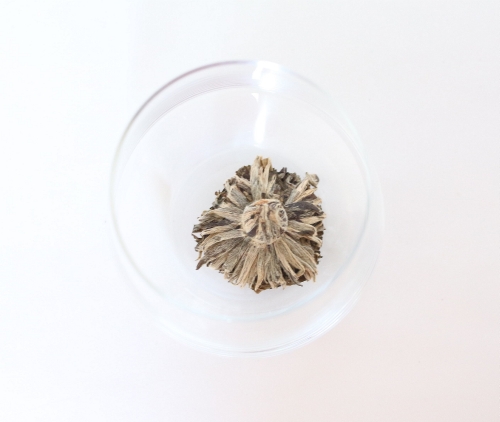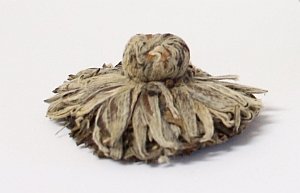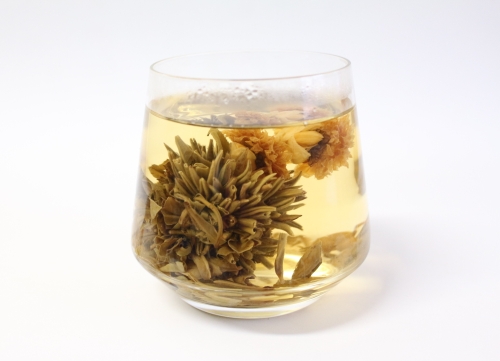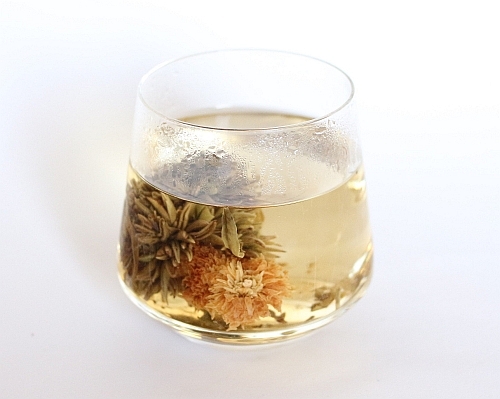The Right Tea Newsletter
–
Issue #42 - November 2021
Welcome to the latest issue of The Right Tea Newsletter!

In this issue we will be doing a tea review. The idea is not only to introduce you to unique teas, but to also encourage you to search for and try new teas and new ways of drinking them.
You never know what wonderful new flavors are out there for you to try and reviewing teas is a great way to expand your horizons.
Doing a tea review is a great way to practice and to develop our senses, tea brewing technique and tea tasting vocabulary.
On this occasion we will be taking a closer look at a flowering tea which requires very specific brewing conditions. So, for this particular tea review we will be foregoing the professional tea tasting set and following the recommendations given by the supplier.
Let’s begin!
Tea Review: Twinings Jin Shan Tian Hua
Sometime ago a friend living in London sent a packet of a very unique tea as a gift: Twinings Jin Shan Tian Hua.
This Jin Shan Tian Hua is so much more than a Chinese green tea, it is a flowering tea that celebrates both the wonderful flavor of tea, but also the beauty of chrysanthemum flowers.
Flowering tea balls have become more common over time, not only have they become easier to purchase, but there are now in varying price ranges.

Tea Profile
This tea from Twinings is labeled as a loose leaf tea, but by looking at it, that’s the last thing this tea seems: loose.
Shaped much like a straw hat, these tea “balls” are made of Chinese green tea leaves hand sown around chrysanthemum flowers.
This green tea comes from the province of Anhui in China, and makes up about 95% of the tea balls, the other 5% are the chrysanthemum flowers delicately packed inside.
Dry Leaf
Appearance

The green tea leaves are not uniform, although most present a flat needle-like shape, they vary a bit in size, with dark green colors contrasting with the silvery fur from that is common to find in the bottom part of young tea leaves.
Aroma
Place a tea ball inside your hands and gently blow hot air on it. This will help to release aromas that you may not detect just by sniffing directly the full packet. Try this with any loose leaf tea you have at home, you will be surprised the perfume of your tea.The dried tea ball releases a sweet aroma, much like a diluted floral honey and delicately steamed vegetables.
Brewing Instructions
The suggested brewing instructions are as follows:
- Quantity: 1 flower per person.
- Boil water, leave to cool for 5 minutes. At room temperature, this will lead to water at about 80ºC (176ºF).
- Allow to steep 3 minutes, increase time slightly when reinfusing.
- Use a large or tall glass for the blooming experience.
- No milk (this one seems rather obvious, green teas don’t handle milk very well and you’d just be hiding the whole blooming experience).
It’s when you infuse the tea balls that the magic begins and this is where using a large glass cup or a small glass teapot makes all the difference.
When you pour the water over the tea ball you may feel a bit discouraged – well, I did at least, because for the first 30 seconds it may seem that you have bought a dud and that the tea ball will never open up.
What you may have missed is that little air bubbles have begun to be released from the tea ball and slowly the leaves begin to unfurl and the chrysanthemum flowers will bloom, one after the other.
You may need to use a timer to make sure you stick to the 3 minutes of infusion time, otherwise it is incredibly easy to get lost in admiring your tea… I almost did.
Wet/Infused Leaf
Appearance

The tea leaves when infused open up, still remaining attached to the center of the tea ball, but you can clearly see that they are unfurling.
They retain most of their needle like shape and are much more uniform in color. They become an even olive green and the fuzzy silver hairs are nearly invisible now.
The beautiful flowers are a beautiful pink and seem attached to the center, popping one on top of the other.
Aroma
The aroma of the dried leaves persist and it is even stronger in the infused leaves. There is an obvious floral and honey sweetness and vegetable like aromas coming from the leaves and flowers.
Tea Liquor
Appearance

The brewed tea is a lovely clear liquid with golden color. Even if you let the tea flower infuse longer, it will not become much darker than the initial golden tone.
Yes, some teas will turn slightly amber, but this did not seem to be the case which is why you need to keep your eye on the timer, because the tea liquor will not give you an idea of how strong it is becoming.
Note: on reinfusing the tea, the tea liquor may appear to be a slightly paler yellow, but it will eventually reach the golden yellow again.
Aroma
The tea has the same, just perhaps slightly weaker, sweet honey and floral notes of the tea leaves mixed with the vegetable, spinach-like, aroma typical of Chinese green teas.
The package referred to pine-like aromas that may be associated with the sweetness that is easily identifiable.
Taste
This is a delicate tea, with very typical Chinese green tea notes. When the tea is hot, it is very pleasant, floral and vegetable flavors are easily identifiable, with no astringency and no long-lasting aftertaste.
As the tea cools down, it becomes a different experience. Astringent bitter notes begin to come through, and the other flavor become more muted. You may also feel some dryness in the mouth that was not there before and this is a longer lasting feeling.
Final Considerations
This is an amazing tea and its flavor alone is worth the purchase. Here are some notes that you should take into consideration when brewing this tea or one like it:
Getting the water temperature right:
- Firstly, while it may be tempting to pour freshly boiled water straight onto the tea, not allowing it to cool down, it really makes a difference when it comes to developing the right flavors in the tea.
- Pouring boiling water straight on to the green tea could cause it to become bitter and you would miss out on the floral and sweet delicate notes of a tea like this.
- Using boiling water could also ruin the tea for further infusions. It is harder to recreate the same flavor from tea leaves that have been cooked due to high temperatures.
Choosing the right brewing vessel:
- Larger vessel the better! I was using a large glass tumbler and the tea ball still seemed confined. With more water and a deeper vessel, the flowers could have come into full display when blooming.
- Ideally this tea should be brewed in a small glass teapot so that you can pour out the tea and stop the infusion and thus get the most out of a second, even third or fourth infusions. Reinfusions may be weaker, but still delicate and delicious.
The perfect bloom:

- The tea balls may be delicate, particularly when they come in odd shapes. The Jin Shan Tian Hua is shaped like a little straw hat and if roughly handled leaves could break off and ruin the blooming effect. So, it should be stored carefully and placed carefully in the pot or glass when brewing.
- Sometimes tea balls start blooming upside down in the hot water. Some cheaper lower quality tea balls may do this. It has to do with how the air trapped inside begins to be released.
- If once the flower is released it is still not facing the right way up, you may help it by very gently coaxing the tea ball to turn upright with a teaspoon. You need to be gentle so as not damage the bloom and cause leaves to be released and ruining the balance of the tea ball.
In the end, the great thing about these flowering teas is that they are really fun and they taste great.
These days flowering teas are easy to find and most well-known tea brands have them on their catalogue. And if nothing else you can brew one is a large glass and use it as decorative item for the table at your next tea party.
Read more about these teas here: Flowering teas

Be inspired and try new different teas!
What’s Next?
More articles about tea are coming, so keep on the lookout for the next issue of our newsletter. While you wait, look around our website and learn more about tea and its health benefits.
Until then make sure to follow us on Facebook for daily tips and other wonderful tea related items.
Follow us also on Pinterest!
Comments / Suggestions
If you have any comments or suggestions regarding this newsletter or anything you would like to see on the website, make sure to contact us using the form you will find here:
Search Website:
Be healthy
with a wide
choice of herbs!

Prepare your tea!
Try these
Tea Samplers!

Wellness Pack at ArtofTea.com

Award Winning Pack ar ArtofTea.com
Find other
tea time items at ...




